 Kia Optima: Removal
Kia Optima: Removal
| Х |
Use fender covers to
avoid damaging painted surfaces. |
| Х |
To avoid damaging the
cylinder head, wait until the engine coolant temperature drops below
normal temperature before removing it. |
| Х |
When handling a metal
gasket, take care not to fold the gasket or damage the contact surface
of the gasket. |
| Х |
To avoid damage, unplug
the wiring connectors carefully while holding the connector portion. |
|
|
Mark all wiring and hoses to avoid misconnection. |
|
In case of removing the high pressure fuel pump, high pressure fuel pipe,
delivery pipe, and injector, there may be injury caused by leakage of the
high pressure fuel. So donТt do any repair work right after engine stops. |
| 1. |
Remove the engine cover. |
| 2. |
Disconnect the battery negative
terminal (A). |
| 3. |
Remove the air duct (B).
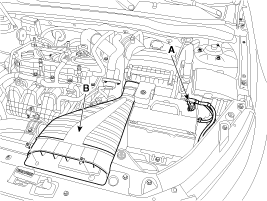
|
| 4. |
Remove the air cleaner assembly
and the intercooler inlet/outlet hoses. (Refer to Engine and transaxle assembly
in this group) |
| 5. |
Remove the RH front wheel. |
| 6. |
Remove the under covers. |
| 7. |
Loosen the drain plug, and drain
the engine coolant. Remove the radiator cap to drain with speed. (Refer
to Cooling system in this group) |
| 8. |
Disconnect the radiator upper
hose (A) and lower hose (B).
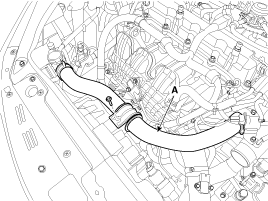
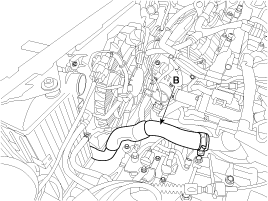
|
| 9. |
Disconnect the wiring connectors
and harness clamps, and remove the wiring protectors from the cylinder head,
intake manifold and exhaust manifold.
| (1) |
Disconnect the exhaust
OCV (Oil control valve) connector (A) and the oxygen sensor connector
(B).
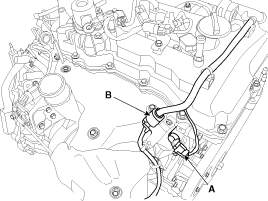
|
| (2) |
Disconnect the A/C compressor
switch connector (A), the alternator connector (B), the OPS (Oil
pressure switch) connector & injector extension connector (C), the
knock sensor connector (D), the MAPS (Manifold absolute pressure
sensor) & IATS (Intake air temperature sensor) connector (E), the
ETC (Electronic throttle control) connector (F) and the vacuum pump
connector (G).
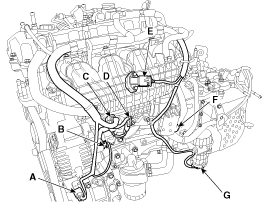
|
| (3) |
Disconnect the ignition
coil connectors (A), the fuel pump connector (B).
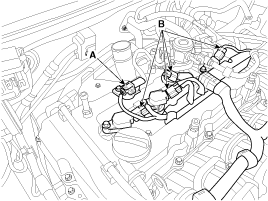
|
| (4) |
Disconnect the PCV hose
(A), the intake OCV (Oil control valve) connector (B) and the OTS
(Oil temperature sensor) connector (C).
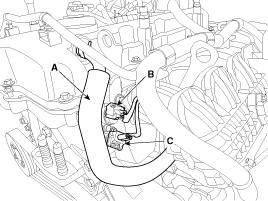
|
| (5) |
Disconnect the ECTS (Engine
coolant temperature sensor) connector (A), the condenser connector
(B), the CKPS (Crankshaft position sensor) connector (C), the exhaust
CMPS (Camshaft position sensor) connector (D) and the electric wastegate
actuator connector (E).
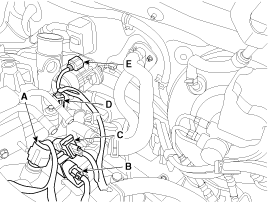
|
| (6) |
Disconnect the intake
CMPS (Camshaft position sensor) connector (A) and the PCSV (Purge
control solenoid valve) connector (B).
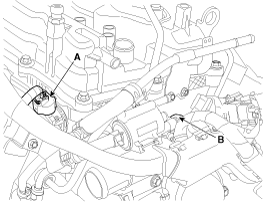
|
|
| 10. |
Disconnect the fuel hose (A)
and PCSV (Purge control solenoid valve) hose (B).
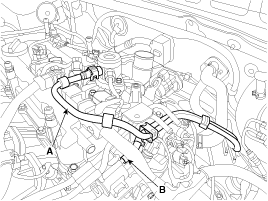
|
| 11. |
Remove the vacuum pipe assembly
(A).
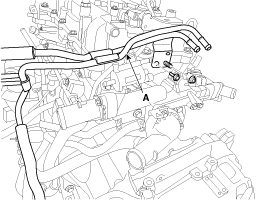
|
| 12. |
Remove the high pressure pipe
(A). (Refer to FL group)
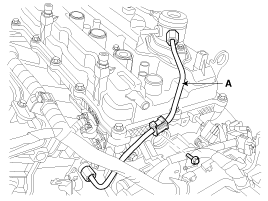
|
| 13. |
Remove the high pressure fuel
pump (A) and the roller tappet (B). (Refer to FL group)
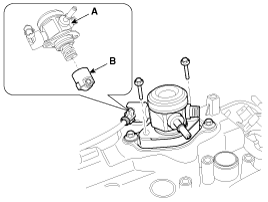
|
| 14. |
Disconnect the heater hoses (A).
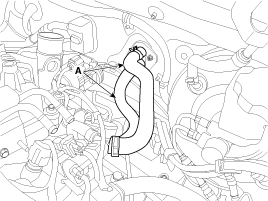
|
| 15. |
Disconnect the throttle body
coolant hoses (A) and the oil cooler coolant hoses (B).
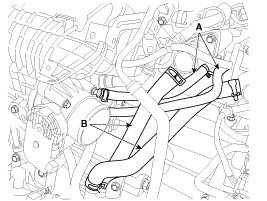
|
| 16. |
Remove the water temperature
control assembly (A) with the water inlet pipe (B).
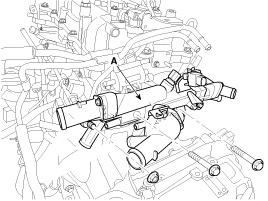
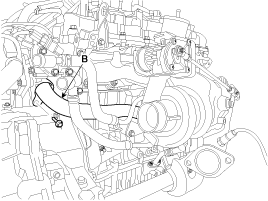
|
| 17. |
Remove the timing chain. (Refer
to Timing system in this group) |
| 18. |
Remove the intake and exhaust
manifold. (Refer to Intake and exhaust system in this group) |
| 19. |
Remove the high pressure fuel
pump bracket (A).
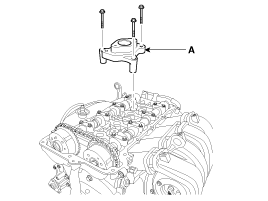
|
| 20. |
Remove the intake CVVT assembly
(A) and exhaust CVVT assembly (B).
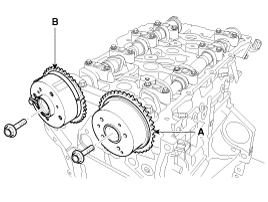
|
When removing the CVVT assembly bolt, prevent the camshaft from
rotating by using a wrench at position A. |
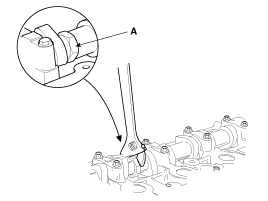
|
| 21. |
Remove the camshaft.
| (1) |
Remove the front camshaft
bearing cap (A) with the upper bearing (B).
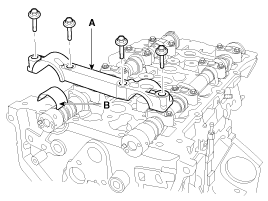
|
| (2) |
Remove the camshaft bearing
cap (A) in the sequence shown.
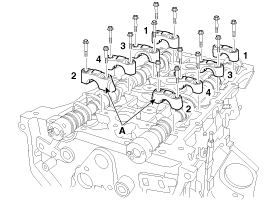
|
| (3) |
Remove the camshafts
(A).
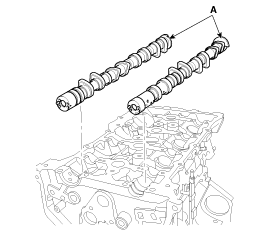
|
| (4) |
Remove the exhaust camshaft
lower bearing (A).
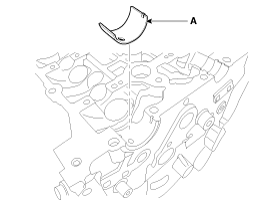
|
|
| 22. |
Remove the intake OCV (Oil control
valve) (A) using a torx wrench and the OTS (Oil temperature sensor) (B).
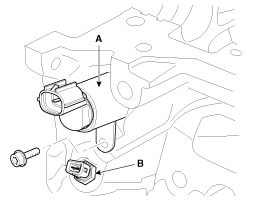
|
| 23. |
Remove the exhaust OCV (Oil control
valve) (A) using a torx wrench.

|
| 24. |
Remove the intake CMPS (Camshaft
position sensor) (A).
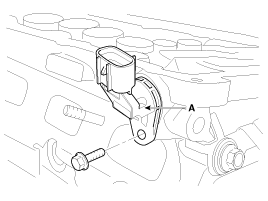
|
| 25. |
Remove the exhaust CMPS (Camshaft
position sensor) (A) after removing the engine hanger (B).
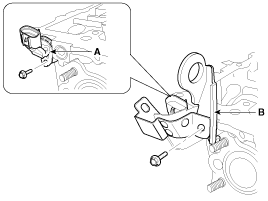
|
| 26. |
Remove the injector & rail module
(A). (Refer to FL group)
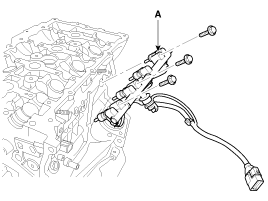
|
| 27. |
Remove the cylinder head.
| (1) |
Using triple square wrench,
uniformly loosen and remove the 10 cylinder head bolts, in several
passes, in the sequence shown. Remove the 10 cylinder head bolts
and plate washers.
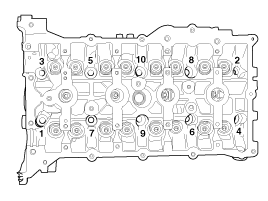
|
Head warpage or cracking could result from removing bolts
in an incorrect order. |
|
| (2) |
Lift the cylinder head
(A) from the dowels on the cylinder block and place the cylinder
head on wooden blocks on a bench.
|
Be careful not to damage the contact surfaces of the cylinder
head and cylinder block. |
|
| (3) |
Remove the cylinder head
gasket (B).
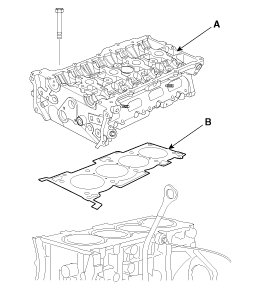
|
|
Identify MLA(Mechanical Lash Adjuster), valves, valve springs as they are
removed so that each item can be reinstalled in its origina ...
See also:
Check spark plugs and ignition
system
Inspect your spark plugs as described in
section 7 and replace them if necessary.
Also check all ignition wiring and components
to be sure they are not cracked,
worn or damaged in any way. ...
Before Starting
Close and lock all doors.
Position the seat so that all controls are easily reached.
Adjust the inside and outside rearview mirrors.
Be sure that all lights work.
Check all gauges.
Check ...
Instrument Cluster. Description and Operation
Description
ECO driving system
This system is designed to encourage eco-driving by providing real-time feedback
to the driver.
The ECO indicator light assists you to drive in the most economical ...
 Kia Optima: Removal
Kia Optima: Removal Disassembly
Disassembly































